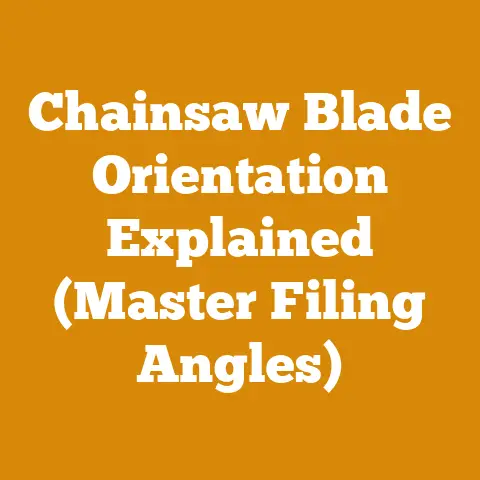5/32 Chainsaw File Guide (7 Expert Tips for Sharp Cuts)
I’ve always believed that the sharpness of your chainsaw is directly proportional to the enjoyment you derive from wood processing. A dull chain is not only inefficient but also a safety hazard, demanding more force and increasing the risk of kickback. That’s why I consider a good chainsaw file guide an indispensable tool, and in this guide, I’ll share my expert tips for using a 5/32 chainsaw file guide to achieve razor-sharp cuts every time. This isn’t just about sharpening a chain; it’s about optimizing your entire woodcutting experience.
Understanding the Importance of Chainsaw Chain Sharpness
A sharp chainsaw chain is crucial for efficient and safe woodcutting. A dull chain requires more force to cut, leading to increased operator fatigue and a higher risk of accidents, such as kickback. A sharp chain, on the other hand, slices through wood with ease, reducing strain on both the operator and the chainsaw itself.
- Efficiency: Sharp chains cut faster and require less fuel, saving time and money.
- Safety: Sharp chains reduce the risk of kickback and other accidents.
- Chainsaw Longevity: Less strain on the chainsaw extends its lifespan and reduces the need for repairs.
- Quality of Cut: A sharp chain produces cleaner and more precise cuts.
The Role of the 5/32 Chainsaw File Guide
The 5/32 chainsaw file guide is specifically designed for chains with a 0.050″ gauge and a 3/8″ low-profile pitch, a common size found on many smaller to medium-sized chainsaws. The guide ensures that each tooth is sharpened to the correct angle and depth, maintaining consistent cutting performance.
- Consistent Sharpening: Ensures each tooth is sharpened to the same angle and depth.
- Proper Angle Maintenance: Helps maintain the correct cutting angle for optimal performance.
- Depth Control: Prevents over-sharpening, which can weaken the chain.
- Ease of Use: Makes sharpening easier and more accurate, even for beginners.
Choosing the Right 5/32 Chainsaw File Guide
Not all file guides are created equal. When selecting a 5/32 chainsaw file guide, consider the following factors:
- Build Quality: Look for a guide made from durable materials like steel or aluminum.
- Ease of Adjustment: The guide should be easy to adjust for different chain types and angles.
- Comfort: A comfortable handle will make the sharpening process more enjoyable.
- Compatibility: Ensure the guide is compatible with your chainsaw chain’s pitch and gauge.
I personally prefer file guides with adjustable settings because they allow me to fine-tune the sharpening process based on the type of wood I’m cutting. I’ve found that softer woods require a slightly more aggressive angle, while hardwoods benefit from a more precise, less aggressive angle.
Key Features to Look For
- Adjustable Angle Settings: Allows for customization based on wood type and cutting conditions.
- Depth Gauge: Ensures consistent sharpening depth across all teeth.
- Ergonomic Handle: Provides a comfortable and secure grip.
- Durable Construction: Made from high-quality materials for long-lasting performance.
- Clear Markings: Easy-to-read markings for accurate angle and depth adjustments.
7 Expert Tips for Achieving Sharp Cuts with a 5/32 Chainsaw File Guide
Here are my top tips for using a 5/32 chainsaw file guide to achieve consistently sharp cuts:
1. Secure Your Chainsaw
Before you even think about sharpening, make sure your chainsaw is stable and secure. I usually clamp the chainsaw bar in a vise, ensuring the chain is free to move. This prevents the chainsaw from moving around while you’re filing, which can lead to inconsistent sharpening and potential injury.
- Vise Mounting: Secure the chainsaw bar in a vise for stability.
- Benchtop Mounting: Use a benchtop mount for added stability and convenience.
- Ground Spikes: For field sharpening, use ground spikes to stabilize the chainsaw.
2. Understand Your Chain
Knowing your chain’s specifications is critical. The 5/32 file is designed for specific chain sizes, typically those with a 0.050″ gauge and 3/8″ low-profile pitch. Using the wrong file size can damage the chain and reduce its cutting efficiency.
- Chain Gauge: The thickness of the drive links that fit into the chainsaw bar groove (typically 0.050″ for 5/32 files).
- Chain Pitch: The distance between three rivets divided by two (typically 3/8″ low-profile for 5/32 files).
- Chain Type: Understanding if your chain is a full chisel, semi-chisel, or other specialty type will influence the angle you choose.
3. Set the Correct Angle
Most file guides have angle markings. I usually start with the manufacturer’s recommended angle (typically 25-30 degrees) and adjust it based on the type of wood I’m cutting. Softer woods may benefit from a slightly steeper angle, while hardwoods require a more precise angle to prevent chipping.
- Manufacturer’s Recommendation: Start with the angle recommended by the chainsaw or chain manufacturer.
- Wood Type Adjustment: Adjust the angle based on the type of wood being cut (softer woods = steeper angle, hardwoods = shallower angle).
- Test Cuts: Make test cuts and adjust the angle as needed to achieve optimal performance.
4. File from the Inside Out
Always file from the inside of the cutter towards the outside. This helps maintain the correct cutting angle and prevents the file from slipping. I use smooth, consistent strokes, applying light pressure. Avoid pressing too hard, as this can damage the file and the chain.
- Direction of Filing: File from the inside of the cutter towards the outside.
- Smooth Strokes: Use smooth, consistent strokes with light pressure.
- Avoid Excessive Pressure: Avoid pressing too hard, as this can damage the file and the chain.
5. Maintain Consistent Pressure
Consistency is key. I try to apply the same amount of pressure with each stroke, ensuring that each tooth is sharpened evenly. Uneven sharpening can lead to the chain pulling to one side or vibrating excessively.
- Equal Pressure: Apply equal pressure with each stroke.
- Consistent Strokes: Maintain consistent strokes for even sharpening.
- Check for Unevenness: Regularly check for unevenness and adjust your technique as needed.
6. Check the Depth Gauges (Rakers)
The depth gauges, or rakers, control how deeply the chain cuts. If they are too high, the chain won’t cut effectively. If they are too low, the chain will grab and kick back. I use a depth gauge tool to ensure they are set to the correct height, typically around 0.025″ below the cutting edge.
- Depth Gauge Tool: Use a depth gauge tool to measure and adjust the height of the rakers.
- Raker Height: Typically around 0.025″ below the cutting edge.
- Filing the Rakers: Use a flat file to lower the rakers as needed.
7. Test and Adjust
After sharpening, always test the chain on a piece of wood. If the chain cuts straight and smoothly, you’ve done a good job. If it pulls to one side or vibrates excessively, re-sharpen the affected teeth and re-check the depth gauges.
- Test Cuts: Make test cuts to evaluate the chain’s performance.
- Straight Cuts: Ensure the chain cuts straight and smoothly.
- Adjustments: Re-sharpen or adjust the depth gauges as needed based on the test cuts.
Understanding Chain Types and File Selection
Different chain types require different file sizes and sharpening techniques. Here’s a quick overview:
- Full Chisel Chains: These chains have square-cornered teeth and are very aggressive, ideal for clean wood. They require precise sharpening to maintain their cutting edge. I typically use a slightly finer file for these chains to avoid over-sharpening.
- Semi-Chisel Chains: These chains have rounded corners and are more forgiving, suitable for dirty or frozen wood. They don’t require as much precision when sharpening, but it’s still important to maintain the correct angle and depth.
- Low-Profile Chains: These chains are designed for smaller chainsaws and have a lower kickback risk. They typically require a smaller file size, such as the 5/32, and a shallower sharpening angle.
File Size Chart for Common Chainsaw Chains
| Chain Pitch | Chain Gauge | Recommended File Size |
|---|---|---|
| 3/8″ LP | 0.050″ | 5/32″ |
| 0.325″ | 0.050″ | 3/16″ |
| 3/8″ | 0.050″ | 7/32″ |
| 3/8″ | 0.058″ | 13/64″ |
| 0.404″ | 0.063″ | 7/32″ or 1/4″ |
Safety First: Protecting Yourself During Chainsaw Maintenance
Sharpening a chainsaw involves working with sharp tools, so safety should always be your top priority. Here are some essential safety precautions:
- Wear Gloves: Protect your hands from cuts and abrasions. I prefer leather gloves for their durability and grip.
- Wear Eye Protection: Prevent metal filings from entering your eyes. Safety glasses or a face shield are essential.
- Secure the Chainsaw: Ensure the chainsaw is stable and secure to prevent accidents.
- Work in a Well-Lit Area: Good lighting will help you see what you’re doing and avoid mistakes.
- Stay Focused: Avoid distractions and concentrate on the task at hand.
Personal Protective Equipment (PPE) Checklist
- Safety Glasses or Face Shield: Protect your eyes from flying debris.
- Gloves: Protect your hands from cuts and abrasions.
- Hearing Protection: Protect your ears from the noise of the chainsaw.
- Steel-Toed Boots: Protect your feet from falling objects.
- Chainsaw Chaps: Protect your legs from accidental cuts.
Troubleshooting Common Chainsaw Sharpening Issues
Even with the best techniques, you may encounter problems while sharpening your chainsaw. Here are some common issues and how to fix them:
- Chain Pulls to One Side: This usually indicates that some teeth are sharper than others. Re-sharpen the duller teeth and ensure they are all the same length and angle.
- Chain Vibrates Excessively: This can be caused by uneven depth gauges. Use a depth gauge tool to adjust the rakers to the correct height.
- Chain Cuts Slowly: This could be due to dull teeth or depth gauges that are too high. Sharpen the teeth and lower the depth gauges as needed.
- File Slips: This can be caused by a worn-out file or insufficient pressure. Replace the file and apply more consistent pressure.
Case Study: Restoring a Neglected Chainsaw Chain
I once inherited a chainsaw from a friend who had neglected its maintenance for years. The chain was incredibly dull, and some of the teeth were even damaged. Here’s how I restored it to its former glory:
- Inspection: I carefully inspected the chain, identifying any damaged or severely worn teeth.
- Filing: Using my 5/32 file guide, I began sharpening each tooth, paying extra attention to the damaged ones. I used a slightly more aggressive angle to remove the damage and restore the cutting edge.
- Depth Gauge Adjustment: After sharpening, I used a depth gauge tool to adjust the rakers to the correct height.
- Testing: I tested the chain on a piece of wood and was amazed at the improvement. It cut straight and smoothly, just like a new chain.
This experience taught me the importance of regular maintenance and the power of a good file guide.
Maintaining Your Chainsaw File Guide
A good chainsaw file guide is an investment, so it’s important to take care of it. Here are some tips for maintaining your file guide:
- Clean Regularly: Wipe the file guide clean after each use to remove dirt and debris.
- Lubricate Moving Parts: Apply a small amount of oil to the moving parts to keep them working smoothly.
- Store Properly: Store the file guide in a dry place to prevent rust and corrosion.
- Replace Worn Parts: Replace any worn or damaged parts as needed.
Longevity Tips for Your File Guide
- Keep it Clean: Wipe down the guide after each use to remove wood dust and metal filings.
- Store it Dry: Moisture can cause rust, so store your file guide in a dry place.
- Oil Moving Parts: A drop of oil on the adjustable parts will keep them moving smoothly.
- Replace Files Regularly: Dull files are less effective and can damage your chain, so replace them as needed.
- Check for Wear: Periodically inspect the guide for wear and tear, and replace any worn parts.
Advanced Techniques: Customizing Your Sharpening
Once you’ve mastered the basics of chainsaw sharpening, you can start experimenting with advanced techniques to customize your sharpening based on your specific needs.
- Adjusting the Top Plate Angle: The top plate angle affects the chain’s aggressiveness. A steeper angle (closer to 35 degrees) will make the chain more aggressive but also more prone to kickback. A shallower angle (closer to 25 degrees) will make the chain less aggressive but safer.
- Adjusting the Side Plate Angle: The side plate angle affects the chain’s ability to cut sideways. A steeper angle will make the chain better at cutting sideways, while a shallower angle will make it better at cutting straight.
- Using Different File Shapes: Different file shapes can be used to achieve different cutting characteristics. A round file is best for general-purpose sharpening, while a square file can be used to create a more aggressive cutting edge.
Data-Backed Insights on Wood Strength and Drying
Understanding wood properties is crucial for efficient wood processing. Here are some data points to consider:
- Wood Moisture Content (MC): Freshly cut wood can have an MC of 50% or higher. For firewood, the ideal MC is below 20%.
- Drying Time: Air-drying firewood typically takes 6-12 months, depending on the wood species and climate. Kiln-drying can reduce the MC to below 10% in a matter of days.
- Wood Strength: Hardwoods like oak and maple have a higher density and strength than softwoods like pine and fir. This affects the chainsaw’s cutting performance and the sharpening requirements.
Table: Common Wood Species and Their Properties
| Wood Species | Density (kg/m³) | Moisture Content (Freshly Cut) | Drying Time (Air Dry) |
|---|---|---|---|
| Oak | 750 | 60% | 12-18 months |
| Maple | 700 | 55% | 9-15 months |
| Pine | 450 | 45% | 6-9 months |
| Fir | 400 | 50% | 6-12 months |
Conclusion: The Path to Chainsaw Mastery
Mastering the art of chainsaw sharpening with a 5/32 file guide is an investment that pays off in terms of efficiency, safety, and enjoyment. By following these expert tips and understanding the principles of chain maintenance, you can achieve consistently sharp cuts and extend the life of your chainsaw. Remember to prioritize safety, maintain your tools, and always test your work. With practice and patience, you’ll become a chainsaw sharpening pro in no time. I hope this guide has been helpful, and I wish you many happy and productive hours of wood processing!






